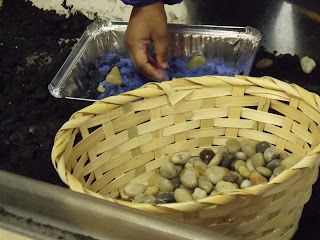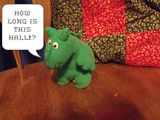Beginning last week with the animals stuck in the mud, I have been introducing the children to "mud play". Of course, for most children, this would not be a skill that would need to be taught. Most preschool children would jump right in and explore mud in a variety of ways!
For some children with more significant special needs, play may need to be specifically taught. While there are times to use scripted play schemes or joint action routines, I tend to try to keep this type of play as similar as possible to what a typically developing child would experience.
In this case, I presented the children with the "mud" in the sensory table, a basket of rocks, a few cake pans, some scoops and some plastic salt shakers filled with blue sand!
As the children began exploring the mud, I brought out the scoops and cake pans and demonstrated how they could scoop the mud into the cake pans and pat it down. I allowed them to attempt and then brought out the rocks and showed them how they could push them down into the mud in the cake pan. I finally brought out the salt shakers of sand and demonstrated how to shake them on the "cake". (...and then we shook, shook, shook and emptied the salt shakers!)
Later this week, I may introduce a more scripted play scheme using these materials; but for now, I wanted the children to experience this play in the most natural way possible. While this is a natural play experience, several things are changed in order to assist the children in exploring this and in order to increase the odds that they will then explore this in a new environment (outdoors) and with more children.
Here are the things that are a bit different for my group than for most preschool groups:
The last step in this sequence is to introduce this type of play (with these materials) in a completely natural setting (outside). Once the children have a few play schemes they feel comfortable engaging in, repeating or watching, it is more likely that the most natural play will go well and will be a positive experience for the children!
NOTE: Even with these adaptations, not all children will participate in this activity. Many children with sensory processing difficulties will find this type of play very difficult to engage in. I often find an alternative activity for children who will find this type of play overwhelming or overstimulating. However, rather than simply allowing the child to avoid this altogether, we work with the child at the level they are at in exploring items with various textures/smells etc. and work with them in a very sequential way in order to explore more items.
For some children with more significant special needs, play may need to be specifically taught. While there are times to use scripted play schemes or joint action routines, I tend to try to keep this type of play as similar as possible to what a typically developing child would experience.
In this case, I presented the children with the "mud" in the sensory table, a basket of rocks, a few cake pans, some scoops and some plastic salt shakers filled with blue sand!
As the children began exploring the mud, I brought out the scoops and cake pans and demonstrated how they could scoop the mud into the cake pans and pat it down. I allowed them to attempt and then brought out the rocks and showed them how they could push them down into the mud in the cake pan. I finally brought out the salt shakers of sand and demonstrated how to shake them on the "cake". (...and then we shook, shook, shook and emptied the salt shakers!)
Later this week, I may introduce a more scripted play scheme using these materials; but for now, I wanted the children to experience this play in the most natural way possible. While this is a natural play experience, several things are changed in order to assist the children in exploring this and in order to increase the odds that they will then explore this in a new environment (outdoors) and with more children.
Here are the things that are a bit different for my group than for most preschool groups:
- Our group size is very small. I have a total of 5 children in my classroom and 4 adults.
- We spend a great deal of time with the same materials- without introducing any new ones (generally a week or more).
- I control the variables to the play: we introduce new play in a very controlled environment (the classroom) rather than starting with outdoor play (where there are clearly many more variables).
The last step in this sequence is to introduce this type of play (with these materials) in a completely natural setting (outside). Once the children have a few play schemes they feel comfortable engaging in, repeating or watching, it is more likely that the most natural play will go well and will be a positive experience for the children!
NOTE: Even with these adaptations, not all children will participate in this activity. Many children with sensory processing difficulties will find this type of play very difficult to engage in. I often find an alternative activity for children who will find this type of play overwhelming or overstimulating. However, rather than simply allowing the child to avoid this altogether, we work with the child at the level they are at in exploring items with various textures/smells etc. and work with them in a very sequential way in order to explore more items.







I am sure kids will love this activity, thanks!
ReplyDeleteCheck out my recent post @ http://blog.memetales.com/2011/03/paper-necklace-kids-craft/